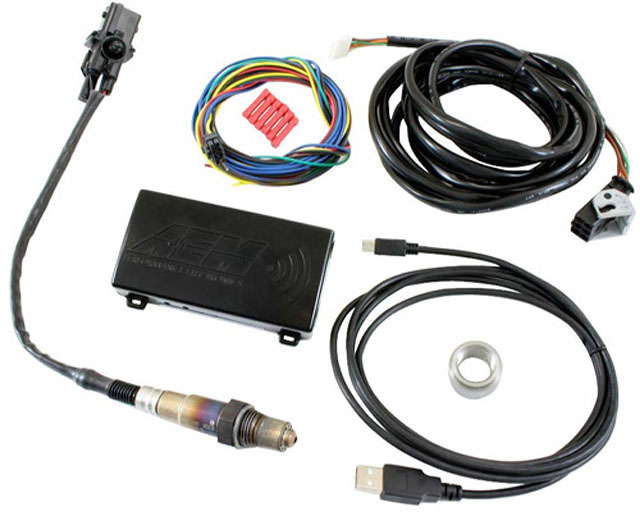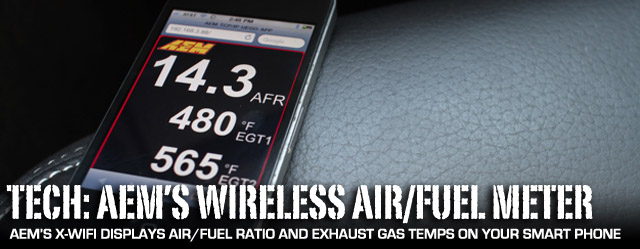Monitoring your engine’s air/fuel ratio (AFR) is one of the most important sensors from a tuning and safety stand point. It can be so critical to a tuner, that they will stick an O2 sensor in every header primary to monitor each cylinder individually. Now, this is overboard for most street cars, which leads us to the newest product from AEM Electronics, the X-WIFI.
The availability of wideband oxygen sensors has made monitoring AFR more accurate than ever before. The latest sensors from Bosch Electronics are said to be accurate to plus or minus .1 AFR units. Before this contemporary technology emerged, the same kind of work was done by measuring exhaust gas temperatures (EGT). Merge that with the latest in gauge technology you have the ability to monitor a single channel air/fuel ratio and dual channel EGTs… all wirelessly from your phone!

The AEM X-WIFI wirelessly streaming air/fuel and EGT data directly from our iPhone, though the X-WIFI will work with any phone that can connect to a network with internet capability. The X-WIFI is supplied with a Bosch oxygen sensor, exhaust bung, sensor cable, control module, data cable and wiring supplies.
Typically air/fuel ratios will hover around the 14.7:1 AFR mark under cruising and idling. This is the ideal ratio that it takes to cleanly burn all the fuel and air in the combustion chamber, resulting in the cleanest emissions and best gas mileage. Now, under wide open throttle those ratios can change from around 13:1 for naturally aspirated combinations to 11.5:1 for forced induction. But EGTs are an important part too…
So, how hot should your EGT be? Well, that depends on way too many factors to make any kind of general statement. Ideally, you’d monitor the temperature output from the leanest cylinder, find the highest EGT and dial in the appropriate amount of fuel. Handling this kind of tuning on a dyno will give you a good idea of how much more fuel to use.
The availability of wideband oxygen sensors, however, has pretty much made EGT-based tuning less critical for a typical street/strip car, but it can still be helpful for monitoring the engine on a cylinder by cylinder basis. Regardless, some people prefer the belt and suspenders approach, so a new product from AEM Electronics gives you the choice to monitor AFR, or AFR and EGT at the same time.
Product Information
AEM X-WiFi: Wireless Real-Time Engine Data Monitoring PN # 30-2320
• No free air calibration required
• Ideal AFR monitoring tool for EFI and carbureted applications, and engine dynamometers
• No laptop or dedicated display required for monitoring
• Includes Bosch 4.2 sensor for optimum accuracy and reliability
• Accurate to 0.1 AFR
• Optional EGT sensors sold separately
• 0-5v analog outputs included (AFR, EGT1, EGT2) for use with data loggers and virtually any engine management system
• Serial data stream included for output of AFR and EGTs via USB cable
• Detects AFR sensor problems and outputs error values which can be used to deactivate feedback
• Reads EGTs from 0-1800F
The Wireless World Arrives
There are more than a few AFR gauge kits around, but the move to digital technology is defining what new products will do. The AEM X-WIFI is based on the Bosch 4.2 oxygen sensor that plugs into the supplied controller module. The Bosch sensor must be installed in the exhaust system, either by replacing an existing sensor, or welding the supplied threaded collar to the exhaust system, ahead of any catalytic converters.
The control module itself only needs power and ground connections and can be mounted anywhere inside the vehicle. The optional EGT sensors are K-type thermocouples and will need to be installed close to an exhaust port on either side of the engine.
The X-WIFI connects to any phone that can pick up a wireless connection, though you cannot surf the web as normal when connected to the AEM. You simply enter the X-WiFI's URL into the address bar and it will load the tuner. For the iPhone, you can turn it on its side and zoom into a specific senor you might want to view over a run.
The module does provide a USB output so data can be monitored and recorded using a laptop computer, but it is not necessary to do so. If you have any kind of WiFi-equipped device that runs a web browser, you can also view the data with that. “At its core, the X-WIFI UEGO Controller is a networking device, so it will look for WiFi signals to connect to whether they are phones, computers, etc,” said John Romero of AEM Electronics. “It will connect with any device that is on an ad hoc network, and can connect to older devices and devices on an infrastructure network with a standard router.”
So, if you already have a mount for your smart phone in the car, there is little else to do but dial in the signal from the control module. When we asked Romero about going with a WiFi signal versus Bluetooth he responded, “There really isn’t any difference. The refresh rate is about the same. Plus, you are only transmitting the data for three channels, which is not significant enough to slow down the rate of transmission of this information.” Rather than having to molest your car’s pristine interior to mount a gauge, this provides a clean and easily reversible alternative.
Installation
Our test vehicle of choice happened to be our 2011 Mustang project, “Wild E. Coyote,” and it features a Vortech supercharger and JPC header-back exhaust system that pumps out 600 horsepower to the rear wheels, however the X-WIFI will work on any gas powered vehicle. Making this much power at the wheels on 91 octane made monitoring our EGTs and air/fuel ratios a necessity. While the new Mustangs do come with factory-installed wide band O2 sensors, there is no real way to efficiently monitor them, which is why we installed the X-WIFI.

The first thing you want to figure out is where you want to mount the wideband sensor. Remember that the sensor needs to sit at about a 10 o'clock position. We mounted it in the X-pipe to get an even mixture of both cylinders. "For non-boosted applications, the O2 sensor should be at least 18-inches downstream from the exhaust port," said Romero. "For cars with a turbo, high heat or if you plan to run race gas, we recommend installing it at least 36-inches downstream of the exhaust port. On a turbo car, you must install it after the turbocharger or the pressure differential will skew the accuracy of the unit."

Next the bung is TIG welded onto the X-pipe off of the car. AEM includes a mild steel sensor bung but we opted for a stainless version.

The EGT sensors are tapped into cylinder four and eight, which are typically the leanest sensors on a V8 engine. They are plumbed three inches from the exhaust port on each side and it is important to get both sensors located the same distance from the cylinder head; a matter of one inch could be over 100 degrees different. "We have a few suggestions for installing the EGT sensors that depend on what you want to see," said Romero. "For individual cylinder EGT, we suggest one to two inches from the exhaust port. If you want to see the turbine inlet temperature, we suggest mounting them two to three inches from the turbine inlet. For cylinder bank EGT, we recommend mounting them in the header collectors. If you are logging two banks, and I’m guessing almost anyone reading this will be, it’s important to install both thermocouples at the same distance from the port with the same tip depth, in a same diameter tube so that your readings don’t vary because of installation differences between the two sensors."
The EGT sensors have short pigtails and must be used with AEM's harness extension kit. The wires connect with a small nut and bolt and secured with shrink wrap. Make sure the metal ends of the sensor wiring aren't touching when you finish it with shrink wrap

To isolate the accessory wiring, we ran a simple trigger source relay under the driver's seat. This allows us to install three electronics with a maximum load of 10 amps each. There are three pre-made sensor harnesses that connect on the left side of the controller for the two EGTs and one wide/band. On the right side, a single plug contains 0-5 volt outputs for each of the sensors plus a power and ground. Since we aren't presently using the 0-5 volt signals, it was a simple power and ground switch that needed to be wired. Additionally there is a USB port that allows you to monitor and data log via a laptop.
Helping at the Track
The AEM X-WIFI helped us discover a problem at the track with our supercharged 2011 GT. Plain and simple, weren’t getting the times that we expected. By monitoring the air/fuel ratios during a run, we could see that the Mustang would get progressively richer during a run. The problem in the end? The catalytic converters were triggering an over temperature fault that forced the computer to add additional fuel to the tune. With this problem fixed, we went three tenths and five MPH faster in the quarter mile.
http://youtu.be/9sNazZ_pAOU
Conclusion
Whether you are using the EGT option on this product or not, the WiFi capability sets it apart fom other products currently on the market. The resulting installation is simple and the ability to use a smart phone as a display means that butchering you car’s interior won’t be needed. “We made this for people who don’t want to add another gauge, but want to data log and have access to real-time readings if they desire,” explained Romero. “This way, they can mount their WiFi device in their car as a gauge, or simply connect our X-WIFI UEGO Controller to an EMS or Data Logger to log.” The bonus part is no special applications need to be downloaded to the phone for the X-WIFI to work. It is a clever and elegant solution based on innovative design.






















